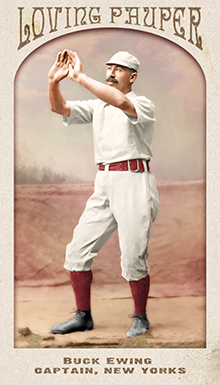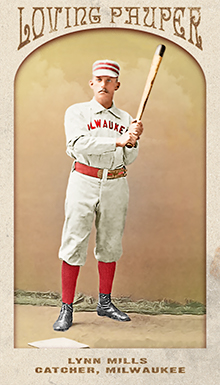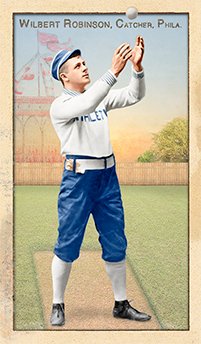- Series: Beginnings: 1880's
- City: Philadelphia
- Team: Athletics (AA)
- League: American Association
- Hall: National Baseball Hall of Fame
Uncle Robbie (1863-1934). A durable catcher for 17 seasons with 3 teams, Robinson is credited as the 1st to play directly behind the plate at all times. Uncle Robbie once caught 5 games in two days. He also had 7 hits & 11 RBI in a single game. After his playing days were over, Robinson went on to manage for 18 seasons.
- Won 3 NL pennants as player
- Won 2 NL pennants as manager
- Won 5 NL pennants as pitching coach
- Elected to Hall of Fame: 1945

- Series: 1880s: Loving Paupers
- City: New York
- Team: Giants
- League: National League
- Hall: National Baseball Hall of Fame
William Ewing (1859-1906) was the premier catcher of the 19th century, honored for decades after his early death as even, perhaps, the greatest player of all time. A scourge at bat, Buck hit over .300 ten times. He played behind the plate with courage and style, crouching close to the hitter so as to shave precious seconds off his inerrant throws. Ewing had debuted with the remarkable Troy Trojans in 1880 and joined four future Hall-of-Famers in moving to NYC in ‘83. The sturdy catcher may have been the primary inspiration for Jim Mutrie’s “my Giants!” exclamation that led to the new identity of the Gothams. An arm injury on a raw spring day curtailed his tenure behind the plate from 1891 on. Such a magnetic figure couldn’t escape the turmoil of the Players’ League controversies and Ewing was sometimes pilloried for lax effort. Despite such caviling, Ewing left as indelible a mark on the game’s first century as anyone. Upon his induction to Cooperstown (among the first six of the “pre-modern” era), he was hailed by Connie Mack as the greatest catcher he had seen and he had seen most.
- “Buck” was a derivative of “Buckingham,” bestowed on the budding star by an admiring scribe who wanted to add gravitas to the youngster’s reputation
- Played all nine positions and managed 3 different teams over 7 seasons
- Was the first catcher elected to the Hall of Fame; and the second 19th century player elected (after Cap Anson)
- Elected to Hall of Fame: 1939
Auction History
Cartophilia
Old Judge Pose: 149-5
- Series: Athletic of Philadelphia: 1874
- City: Philadelphia
- Team: Athletics (NAPBBP)
- League: National Association (NAPBBP)
John Edgar Clapp (1851-1904) played for 8 teams and managed 6 over a 12 year span, beginning in the National Association with the Middletown Mansfields in 1872 and ending with the NY Gothams in ’83. Primarily a catcher, Clapp had a career BA of .283. With a lifetime 2,523 ABs, he struck out only 51 times.
- Was the first player-manager in major league history (1872)
- Jay Jaffe's JAWS system ranks John as the 88th best catcher in MLB history, just after Bubbles Hargrave and before Ed McFarland
- Earned the nickname “Honest John” after reporting a bookie’s attempted bribe to local police
- The 1881 bribe, in current dollars, amounted to @$119,000
- Fittingly, this Honest John entered police work after retirement from the game and died on the job in his hometown of Ithaca, NY

- Series: 1880s: Loving Paupers
- City: Milwaukee
- Team: Creams
- League: Western Association
Lynn Mills (1862-1937) was a native of Whitewater, WI. He moved to nearby Milwaukee to begin his professional baseball career with the Brewers in 1886. The team was also known as the Cream Citys or Creams after the distinctive local bricks made from a light-colored clay. We lack data on Mills' rookie season, but his performance in '87 was very positive. He batted .290, splitting time as a reserve at short and third. In 1888 the club transitioned from the Northwestern League to the Western Association and Lynn stayed with them through the '89 campaign. He got more playing time, but his average subsided a bit to .260 in '88 and .266 in '89. The following year Mills moved way out west to play for Spokane in the Pacific Northwest League where he had his most prolific year in all offensive categories. He hit .284 and had 103 base hits including 14 doubles as the regular catcher, a position he had played in Milwaukee. Sketchy minor league records indicate Mills returned to the midwest for the 1891 season with the Terre Haute Hottentots of the Northwestern League, but individual stats aren't available. Baseball Reference even shows him returning to Spokane, this time with the Indians of the Pacific National League in 1903, where the then 41-year-old is on the roster but with no record of positions played or batting statistics. It seems unlikely that Mills would have remained out of pro ball for a decade after showing good promise at the plate, especially for a catcher. It also seems unlikely that a youngster of his talent would have had no professional experience prior to age 24, when he is first shown to be with the Cream Citys. Sadly, extant minor league statistics leave too many gaps in our knowledge of the real contributions of stalwarts such as Lynn Mills.
- The Goodwin editors assert that Mills struggled with his defense in Milwaukee to the extent that, for the 1889 season, he ranked next-to-last in the Northwestern League in defense among catchers. Nevertheless, his ability to hit consistently would have assured him a job behind the plate for many teams in an era that devoured receivers who braved the job with little protective equipment
- Mills enjoys six known poses in the Old Judge canon
Auction History
Cartophilia
Old Judge Pose: 326-1

- Series: 1880s: Loving Paupers
- City: Chicago
- Team: White Stockings
- League: National League
Joseph Andrews Sommers (1866-1908) was a catcher in the days when the position exacted a heavy toll on its players. Perhaps this accounts for why Pete could last four seasons in the majors despite having no discernible skills in the batter’s box. He hit .181 his rookie year in the lesser circuit of the day, the American Association. He debuted with the New York Metropolitans, a struggling club under Dave Orr’s direction in 1887. Sommers got into a mere 33 games, but did contribute a dozen RBI. The following year Pete moved to the National League where he would remain during his major league tenure with Boston’s Beaneaters, the Chicago White Stockings, Indianapolis Hoosiers, New York Giants and Cleveland Spiders. He split the ‘89 season between Chicago and Indianapolis and was in NY and Cleveland for his final turn in 1890. Overall Sommers managed to hit a combined .198 in these four years. Nevertheless, the risks of being the backstop in the days before modern protective gear were such that a high batting average was hardly necessary to fill in at catcher and Sommers got to be part of some of the noteworthy teams of the decade. His MLB experience was less than half of Pete’s pro career. He had started out with Cleveland’s Forest Cities in the Western League in 1885 and saw limited service as late as 1896 with the Quincy, IL Ravens.
- In ‘92 Pete was a regular with the Terre Haute Hottentots (a simpler time!) of the Illinois-Iowa League where he hit .250
- During his season in the Big Apple, Sommers proved to be a sturdy oak behind the plate. News reports described a collision with Orr that left the player/manager out cold and missing two teeth. Apparently, Sommers and first-baseman Orr were trying for the same pop-up. Unknown if Pete held onto the ball
Auction History
Cartophilia
Old Judge Pose: 430-4




